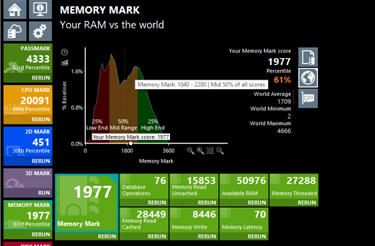

- #Hardware benchmark testing software#
- #Hardware benchmark testing Pc#
- #Hardware benchmark testing download#
HWMonitor is a great program for showing this kind of stuff in a simple table format as it not only tracks real-time data, but also minimums, maximums, and average values.
#Hardware benchmark testing software#
More advanced monitoring software is required if you need in-depth statistics about frequencies, power usage, temperatures, voltage, and other data points. But if you're just trying to get a quick score for your hardware or you're trying to optimize the performance of your PC, realistic benchmarking is probably what you ought to be doing instead. If you're trying to hit the highest benchmark scores for bragging rights or pure curiosity, scientific benchmarking is probably what you want to do. Reviewers might also take a pseudo-realistic approach for scientific benchmarking, where the conditions are still controlled, but tweaked to reflect a typical user's PC. For end users, this basically just means running benchmarks under normal conditions, with your usual background applications open, using the settings you tend to use, and using your regular hardware. Though obviously, none of us use our computers like this, and results from scientific benchmarks would be essentially unrealistic, which is why you'll probably benchmark more realistically unless you're a reviewer. That's basically all there is to the methodology of scientific benchmarking. Basically, you want every component a test system (except for the one that's being tested) to be as high-end as possible so that they're not factoring into the data. Hardware is also important in scientific benchmarking since tweaking settings isn't always enough to avoid bottlenecks. Other software-related practices include testing on a fresh operating system, closing as many background tasks as possible, and setting the power settings to maximum. This is to ensure that the GPU isn't limiting performance and to force the CPU to become the limiting factor (referred to as a bottleneck) in performance. For example, in many CPU reviews, you'll see the test system uses really low graphics settings no matter what CPU is being tested. Scientifically benchmarking a component is all about isolating other components and making sure they're influencing the results of a benchmark as little as possible. The former case is scientific benchmarking and the latter is realistic or practical benchmarking, and this is generally where the benchmarking practices of a reviewer and a user will diverge.
#Hardware benchmark testing download#
They’re both free and can provide deeper insights on thermals, frequencies, etc., though they’re not necessary to successfully use Cinebench.Before you even download any software, the first question you ought to ask yourself is why you're benchmarking, and there are two basic answers: you're either benchmarking to find the theoretically highest performance of a component, or to find how a component performs in typical day-to-day use. This widely used tool not only gives benchmarks for both multi-threaded and single-threaded CPU performance, it can also test the stability of your system at the same time with a 10 minute stress test that helps you gauge your CPU temperatures when paired with monitoring software like HWInfo or Hardware Monitor. Several CPU benchmarks exist but we recommend using Maxon’s free Cinebench R23 software. Let’s start with the beating heart of your computer.
#Hardware benchmark testing Pc#
Whole system performance: PC Mark 10, 3DMark.GPU – Superposition, Shadow of the Tomb Raider.These tools will cover all the bases though.

Many, many more benchmarks exist beyond what we’re recommending here, of course. We’ll discuss more intricate details for each of the main components in turn, but here’s a cheat sheet for the hardware types we’ll be covering and their recommended benchmarking software pairing. Along with performance, benchmarking can also test for temperatures, thermal throttling, and even overall PC stability as a side benefit.


 0 kommentar(er)
0 kommentar(er)
